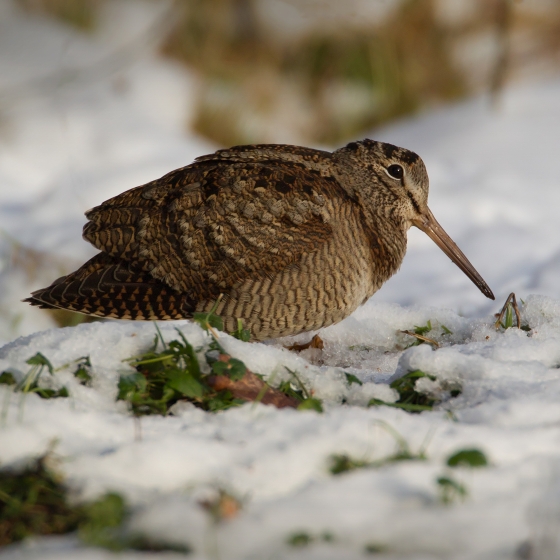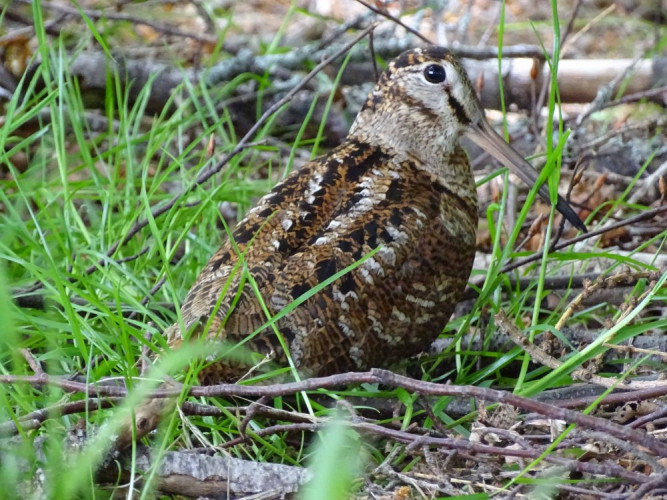Woodcock
Scolopax rusticola (Linnaeus, 1758)
WK
 WOODC
WOODC  5290
5290

Family: Charadriiformes > Scolopacidae

Although a wading bird, the cryptically marked Woodcock is predominantly a bird of woodlands, emerging at night to feed in adjacent fields.
Breeding Woodcock are best detected by their ‘roding’ display, given at dusk and involving birds flying in straight lines above their territories while emitting a grunting call. Atlas data indicate a long-term decline in the breeding population, but core data on changes in the status of the species come from periodic surveys.
In winter there is a strong arrival of Woodcock from the Continent, thought to increase numbers in Britain & Ireland five-fold. Recent ringing and tracking studies have shown that some individuals originate from quite far east. Areas of highest abundance in winter are in North Ireland and north-west Scotland.
Identification
Woodcock identification is often straightforward.
SONGS AND CALLS
Listen to example recordings of the main vocalisations of Woodcock, provided by xeno-canto contributors.
Song
Develop your bird ID skills with our training courses
Our interactive online courses are a great way to develop your bird identification skills, whether you're new to the hobby or a competent birder looking to hone your abilities.
Browse training coursesStatus and Trends
Population size and trends and patterns of distribution based on BTO surveys and atlases with data collected by BTO volunteers.
CONSERVATION STATUS
This species can be found on the following statutory and conservation listings and schedules.
POPULATION CHANGE
The Woodcock declined rapidly and significantly on CBC plots for the three decades up to 2000. Because CBC did not include many coniferous forests and its plots were concentrated in lowland Britain, however, it is not certain how clearly this trend represented the whole UK population at that time. Range contractions, that might have had the same cause as the decline in abundance, were recorded concurrently with part of the CBC decline (Gibbons et al. 1993). BBS is inefficient at recording this scarce, mainly crepuscular species, and cannot continue the index series.
The first special survey aimed at monitoring the UK's breeding Woodcock took place in 2003 and provided a new baseline population estimate for monitoring that was much higher than previously thought (Hoodless et al. 2009). It is important to note, though, that the upward revision of the population estimate is due to new methodology and carries no information about population trends. A repeat survey of breeding Woodcocks conducted by BTO volunteers in spring 2013 found a decline of 29% since 2003 (Heward et al. 2015), which is line with the loss of occupied 10-km squares, also 29%, between 1988-91 and 2008-11 (Balmer et al. 2013).
Through the decline in its UK breeding range, the species moved from amber to being red listed in the latest review (Eaton et al. 2015). The CBC decline had been discounted in 2009 as a reason for the species' amber listing (BoCC3), which rested on the breeding declines recorded across Europe, especially European Russia (BiE04). Annual numbers shot in the UK, which include winter visitors from some declining populations in Europe (generally considered stable), had increased around threefold since 1945 and were running at a historically high level in the early 2000s; however data since 2006 are not shown on the gamebag trend graph.
DISTRIBUTION
Breeding Woodcocks are absent from many of the Scottish islands, much of central and southwest England and large swathes of Wales, western Ireland and the Channel Islands. In autumn there is a large influx of Woodcocks from the Continent, leading to a much wider winter distribution throughout Britain and much of Ireland.
Occupied 10-km squares in UK
| No. occupied in breeding season | 869 |
| % occupied in breeding season | 29 |
| No. occupied in winter | 2672 |
| % occupied in winter | 88 |
European Distribution Map
DISTRIBUTION CHANGE
Woodcock breeding range has contracted markedly and now stands at less than half its 1960s extent, supporting other evidence of a gradual population decline.
Change in occupied 10-km squares in the UK
| % change in range in breeding season (1968–72 to 2008–11) | -52.4% |
| % change in range in winter (1981–84 to 2007–11) | +41.7% |
SEASONALITY
Woodcocks are recorded most often in winter and during spring roding season; records decrease in late summer and early autumn when birds are moulting and less likely to be flushed.

Movement
Information about movement and migration based on online bird portals (e.g. BirdTrack), Ringing schemes and tracking studies.
RINGING RECOVERIES
View a summary of recoveries in the Online Ringing Report.
Foreign locations of birds ringed or recovered in Britain & Ireland

Biology
Lifecycle and body size information about Woodcock, including statistics on nesting, eggs and lifespan based on BTO ringing and nest recording data.
SURVIVAL & LONGEVITY
View number ringed each year in the Online Ringing Report
Maximum Age from Ringing 
|
15 years 5 months 12 days (set in 1937) 
|
Typical Lifespan 
|
4 years with breeding typically at 2 year |
Adult Survival 
|
0.61  
|
Juvenile Survival 
|
0.36 (in first year) 
|
BIOMETRICS
Wing Length 
|
Adults | 200.4±6.4 | Range 190–210mm, N=194 |
| Juveniles | 199.7±5.9 | Range 191-210mm, N=113 | |
| Males | 203.9±5.1 | Range 195–211mm, N=28 |
Body Weight 
|
Adults | 305±45.3 | Range 220–377g, N=145 |
| Juveniles | 303±31.1 | Range 258–345g, N=84 | |
| Males | 291±59.8 | Range 170–360g, N=20 |
Feather measurements and photos on featherbase 
CODES & CLASSIFICATION
Ring size 
|
D or E (pulli E) |
Field Codes 
|
2-letter: WK | 5-letter code: WOODC | Euring: 5290 |
For information in another language (where available) click on a linked name
Research
Interpretation and scientific publications about Woodcock from BTO scientists.
CAUSES AND SOLUTIONS
Causes of change
Various possible causes of the Woodcock's decline have been suggested, but there is no strong hypothesis as yet.
Further information on causes of change
Recreational disturbance, the drying out of natural woodlands, overgrazing by deer, declining woodland management, and the maturation of new plantations are possible causes of the Woodcock's decline, but there is no strong hypothesis as yet (Fuller et al. 2005). Woodcock are more likely to be found in larger woods and those further from urban areas with a mix of habitat types, with birch woods preferred and beech less favoured (Heward et al. 2018).
Information about conservation actions
The causes of the decline in Woodcock are uncertain, but a reduction in the intensity of management of woodlands and overgrazing by deer could both have contributed (Fuller et al. 2005; Hoodless & Hirons 2007); hence actions to control deer and increase the scrub and field layers may benefit this species.
Recent research suggests that the rate of decline is lower in large continuous woodlands (Heward et al. 2015) and that Woodcock are more likely to be found in larger woods further from urban areas (Heward et al. 2018). Therefore, a landscape scale approach which preserves larger woodlands and protects them from fragmentation may also be important. The same research suggests that birch woodlands are preferred and beech is less favoured (Heward et al. 2018).
PUBLICATIONS (2)

Current status and recent trend of the Eurasian Woodcock Scolopax rusticola as a breeding bird in Britain
British Woodcock show declines in breeding population size and range
Results from the 2013 Woodcock Survey show that breeding numbers and breeding range have both declined considerably since the previous survey in 2003. The rate of decline varied regionally but was least pronounced in areas that contained large tracts of continuous woodland.

Habitat correlates of Eurasian Woodcock Scolopax rusticola abundance in a declining resident population
Understanding the influence of habitat upon breeding Woodcock numbers in Britain
Woodcock are in long-term decline. Due to incomplete knowledge of their habitat requirements, there is uncertainty as to what causes these declines. A BTO/GWCT survey investigates Woodcock habitat associations.
Links to more studies from ConservationEvidence.com
Would you like to search for another species?













Share this page